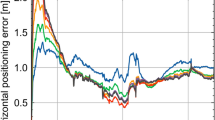Abstract
Mobile robots are generally equipped with proprioceptive motion sensors such as odometers and inertial sensors. These sensors are used for dead-reckoning navigation in an indoor environment where GPS is not available. However, this dead-reckoning scheme is susceptible to drift error in position and heading. This study proposes using grid line patterns which are often found on the surface of floors or ceilings in an indoor environment to obtain pose (i.e., position and orientation) fix information without additional external position information by artificial beacons or landmarks. The grid lines can provide relative pose information of a robot with respect to the grid structure and thus can be used to correct the pose estimation errors. However, grid line patterns are repetitive in nature, which leads to difficulties in estimating its configuration and structure using conventional Gaussian filtering that represent the system uncertainty using a unimodal function (e.g., Kalman filter). In this study, a probabilistic sensor model to deal with multiple hypotheses is employed and an online navigation filter is designed in the framework of particle filtering. To demonstrate the performance of the proposed approach, an experiment was performed in an indoor environment using a wheeled mobile robot, and the results are presented.














Similar content being viewed by others
References
Blanc G, Mezouar Y,Martinet P (2005) Indoor navigation of a wheeled mobile robot along visual routes. In: Proceedings of the 2005 IEEE international conference on robotics and automation, 2005. ICRA 2005. IEEE, pp 3354–3359
Hayet J-B, Lerasle F, Devy M (2007) A visual landmark framework for mobile robot navigation. Image Vis Comput 25(8):1341–1351
Matsumoto Y, Ikeda K, Inaba M, Inoue H (1999) Visual navigation using omnidirectional view sequence. In: Proceedings of 1999 IEEE/RSJ international conference on intelligent robots and systems, 1999. IROS’99, vol 1. IEEE, pp 317–322
Matsumoto Y, Sakai K,Inaba M, Inoue H (2000) View-based approach to robot navigation. In: Proceedings of 2000 IEEE/RSJ international conference on intelligent robots and systems, 2000 (IROS 2000), vol 3. IEEE, pp 1702–1708
Pears N, Liang B (2001) Ground plane segmentation for mobile robot visual navigation. In: Proceedings of 2001 IEEE/RSJ international conference on intelligent robots and systems, 2001, vol 3. IEEE, pp 1513–1518
Dao NX, You B-J,Oh S-R (2005) Visual navigation for indoor mobile robots using a single camera. In: 2005 IEEE/RSJ international conference on intelligent robots and systems, 2005 (IROS 2005). IEEE, pp 1992–1997
DeSouza GN, Kak AC (2002) Vision for mobile robot navigation: a survey. IEEE Trans Pattern Anal Mach Intell 24(2):237–267
Kak AC, DeSouza GN (2002) Robotic vision: what happened to the visions of yesterday? In: Proceedings of 16th international conference on pattern recognition, 2002, vol 2. IEEE, pp 839–847
Abascal J, Lazkano E, Sierra B (2005) Behavior-based indoor navigation. In: Ambient intelligence for scientific discovery. Springer, Berlin, pp 263–285
Bonin-Font F, Ortiz A, Oliver G (2008) Visual navigation for mobile robots: a survey. J Intell Robot Syst 53(3):263–296
Lee Y-J, Yim B-D, Song J-B (2009) Mobile robot localization based on effective combination of vision and range sensors. Int J Control Autom Syst 7(1):97–104
Correa DSO, Sciotti DF, Prado MG, Sales DO, Wolf DF, Osorio FS (2012) Mobile robots navigation in indoor environments using kinect sensor. In: 2012 Second Brazilian conference on critical embedded systems (CBSEC). IEEE, pp 36–41
Biswas J, Veloso M (2012) Depth camera based indoor mobile robot localization and navigation. In: 2012 IEEE International conference on robotics and automation (ICRA). IEEE, pp 1697–1702
Buschmann C, Muller F, Stefan F (2004) Grid-based navigation for autonomous, mobile robots. In: Proceedings of 1st workshop on positioning, navigation and communication 2004 (WPNC’04). Shaker Publishing
Yean YP, Chetty RMK (2012) An efficient grid based navigation of wheeled mobile robots based on visual perception. In: Trends in intelligent robotics, automation, and manufacturing. Springer, Berlin, pp 128–135
Yan J (2012) Improving mobile robot localization: grid-based approach. Opt Eng 51(2):024401-1–024401-7
Mächler P (1997) Robot odometry correction using grid lines on the floor. In: Proceedings of 2nd international workshop on mechatronical computer systems for perception and action, Pisa, Italy
Kim T, Kim J (2013) Beaconless navigation for mobile robots using grid line pattern. In: 2013 10th international conference on ubiquitous robots and ambient intelligence (URAI). IEEE, pp 200–205
Matas J, Galambos C, Kittler J (2000) Robust detection of lines using the progressive probabilistic hough transform. Comput Vis Image Underst 78(1):119–137
Acknowledgments
This work has been supported by “Development of basic SLAM technologies for autonomous underwater robot and software environment for MOOS-IvP” funded by Korea Research Institute of Ships & Ocean engineering (KRISO).
Author information
Authors and Affiliations
Corresponding author
Additional information
Communicated by Sowmya Velsamy.
Rights and permissions
About this article
Cite this article
Kim, T., Kim, J. & Choi, HT. Mobile robot navigation using grid line patterns via probabilistic measurement modeling. Intel Serv Robotics 9, 141–151 (2016). https://doi.org/10.1007/s11370-015-0191-0
Received:
Accepted:
Published:
Issue Date:
DOI: https://doi.org/10.1007/s11370-015-0191-0




